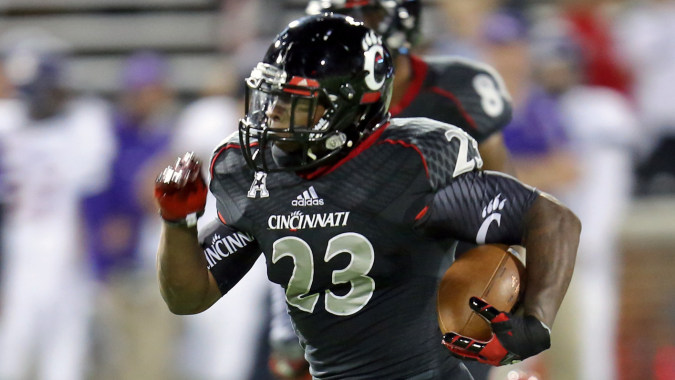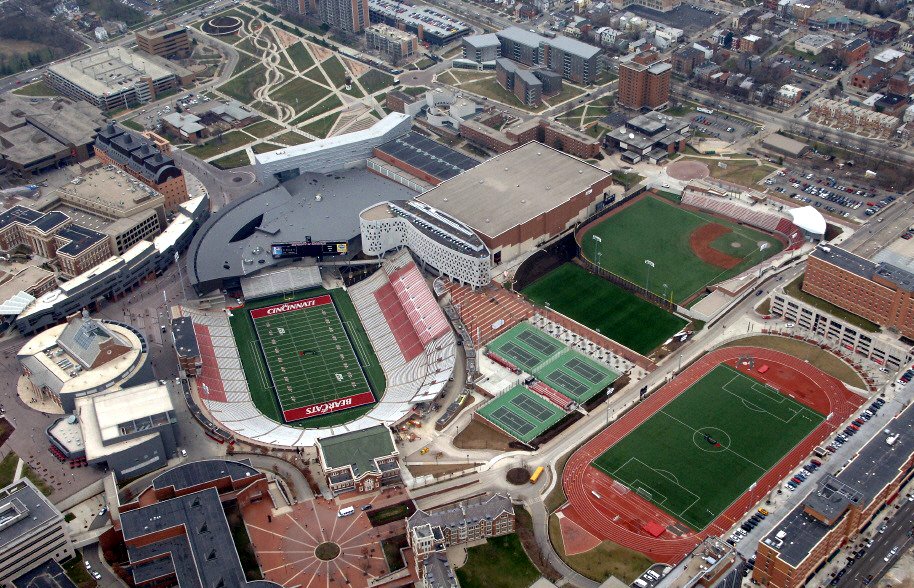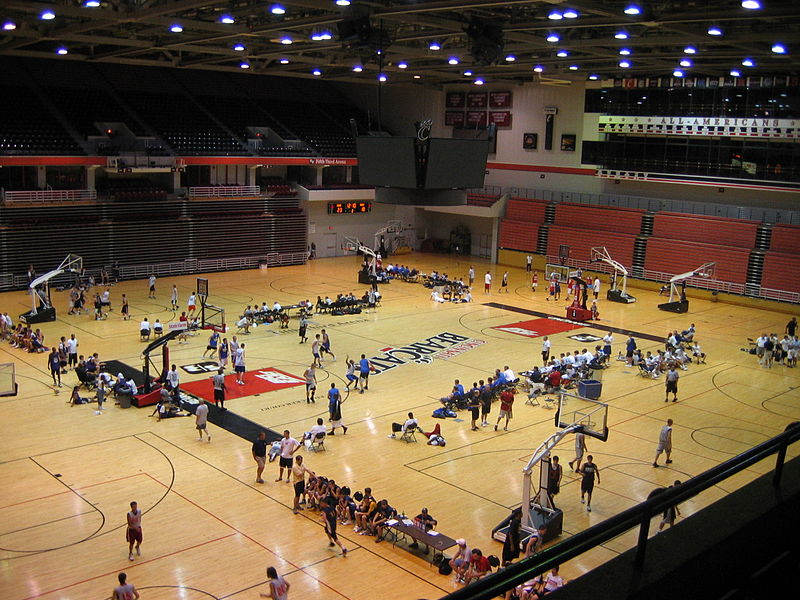
Author’s Note: This is a two part article detailing who the Big 12 should add if they were forced to expand to 12 teams. This is part one which discusses why the Big 12 shouldn’t add Cincinnati. Part two discusses why South Florida and Central Florida are the best expansion candidates for the Big 12.
In a previous article, I explained why the Big 12 should not add BYU and how the Big 12 is better served at ten teams rather than twelve. But the question remains, if the Big 12 was absolutely forced to expand, who should they add and why?
The first thing to remember is that the Big 12 does not have a realistic shot at poaching a school from another Power-Five (P5) conference. The ACC, Big Ten, Pac-12, and SEC all have either a Grant of Rights, which prevents a school from taking its media content to a new school, and/or a more lucrative TV contract. On top of that, schools from the P5 would also lose geographical flexibility, historical rivalries, and academic prestige of their respective conference if they joined the Big 12.
The best Group of Five (G5) expansion target for the Big 12 is Central Florida (UCF) with South Florida as their geographical partner. But before I can explain why the Big 12 would be better off with these two schools, I must address why the University of Cincinnati, which is the most commonly mentioned school as a Big 12 expansion target, is a bad add for the Big 12.
Along with BYU, Cincinnati (UC) is the most commonly mentioned expansion candidate amongst bloggers and by fans on forums. They get brought up largely because of geography and the frequently discussed, “they will be a good travel partner for West Virginia” talking point. While this is a very legitimate argument for the Bearcats inclusion into the Big 12, I believe that this is not enough to justify UC joining the Big 12. There are two problems with Cincinnati for the Big 12.
1. Facilities
Cincinnati’s football stadium is incredibly small for P5 standards. The issue with Nippert Stadium isn’t just its capacity, which is being expanded from 35k to 40k, but the surrounding area. Due to its urban setting, the campus does not have an abundance of space to work with for its athletic facilities.

As you can see from the picture Nippert Stadium has a number of buildings and athletic facilities in the immediate area that are incredibly close to the facility. Keep in mind that this image is from pre-expansion. Here are the post-expansion renderings:

Nippert Stadium has some serious expansion restraints going forward. I am not declaring expansion impossible for the Bearcats, just that the school will be incredibly limited with their expansion options going forward. On top of that there are other issues that the administration would have to accommodate such as parking and pedestrian traffic if the capacity was significantly increased to be more in-line with Big 12 schools. This is a tough pill to swallow for a school who will be entering the Big 12 with the smallest capacity.
Cincinnati’s basketball arena is also a problem. This is Fifth Third Arena where the Bearcats call home:

As you can see from the image the arena does not have a true premium seating section. The only luxury suites in the facility are located behind the baskets, which is the worst view in any basketball arena. In an era where every athletic director is dreaming of ways to increase stadium luxury, Fifth Third Arena puts a virtually non-existent emphasis on that.
The respectful way to put this, the arena has a “non-traditional” look/feel for a P5 facility. The disrespectful way to put this is to say it looks more like a supersized version of a high school gym than a P5 facility.
You may ask, “Why does this matter?” The answer to that is simple. Teams from the P5 (especially Texas and Oklahoma) don’t just care about who they play, but where they play. The Football and Basketball facilities play a huge role in building the image of a conference. The stadiums/arenas are what ultimately get broadcasted over the air and into millions of homes. They size/luxury of these facilities plays a huge factor in how the majority of fans ultimately judge a program. The facilities of an expansion target are mentioned quite often among administrators when discussing conference realignment.
2. The Ohio State/Big Ten problem
The state of Texas is notorious for the way its public FBS schools have to compete with each other for state funding and fan support. While the situation in Ohio may not be as bad as things are in Texas, the two closely mirror each other. The University of Cincinnati is located in Ohio and thus in the shadow of The Ohio State University. The Buckeyes have a political and fan support dominance that is unusual for a state as large as Ohio.
The state of Ohio is by far the largest state with only a single P5 school, and has the most lopsided G5-P5 ratio (7-1) of any state. The reason for this is because Ohio State is willing to fight in order to maintain their stranglehold in the state of Ohio with a “take no prisoners” approach. Now rather than describe how the process works myself, I will instead let the words of my favorite bowtie wearing university president make the case for me.

“There were times when the University of Cincinnati would want something and I would try my hardest to make sure they didn’t get it, even if I wasn’t going to get it either.” (1)
“Even though we love Cincinnati as a city, we want it to be an Ohio State city.” (2)
-Gordon Gee former president of Ohio State University.
While those comments may sound horrible to casual fans, those comments are reflective of the way universities treat each other across the nation. Empires were not forged out of kindness. It is like “hand-to-hand combat” (1) as Gee described it. Schools are always competing with each other to put their institutions in the best possible position to succeed. Ohio State using their vast network of resources and proximity to the Ohio capital will always do whatever is in their power to keep Cincinnati down. Now this isn’t a practice limited specifically to Ohio State, it is a practice seen all across the nation. Ohio State just so happens to have a former university president that is willing to talk about it so bluntly.
So why is this the Big 12’s problem? If the Big 12 were to add Cincinnati, it would mean an influx in additional resources for the school. In addition, it would also give UC a sense of legitimacy that they are for all purposes equal to their Big Ten counterparts. This is something that Ohio State and the Big Ten do not want to happen as it would mean an extra school for the Big Ten to compete with in terms of fan following, recruiting, and prospective students.
There is no other G5 addition that the Big 12 could make that the Big Ten would feel more irritated by. Whether the Big 12 intends to or not, this type of move would be the Big 12 infringing on the Big Ten’s territory. The last time a conference expanded in a manner that made the Big Ten feel threatened was by the ACC when they tried to build a stronger presence in the northeast by adding Notre Dame, Pittsburgh and Syracuse. The Big Ten responded by taking Rutgers and raiding an ACC charter member (Maryland). Combined with a series of other marketing moves, the Big Ten prevented the ACC from laying sole claim to the Northeast.
It is unknown as to whether or not the Big Ten would actually raid the Big 12 in this scenario, but it would most certainly move the Big Ten’s crosshairs towards the Big 12. Given the tremendous wealth, academic prestige, and stability that the Big Ten offers, there are a number of Big 12 schools that wouldn’t think twice before accepting a hypothetical invite from the conference. The best analogy here is to say it is unwise to poke the sleeping bear. That bear may awake one day and come after you, but in the meantime, it is best to let him sleep for as long as possible.
In the meantime…
Gordon Gee’s tendency to say the wrong things ultimately lead to his forced resignation “retirement” from Ohio State. However, the story doesn’t end there for Cincinnati fans.

Gordon Gee is now president of none other than WVU.
The Big 12 should think bigger
I perfectly understand the rationale that countless people have put forward about Cincinnati. They do act as a bridge that helps West Virginia (WVU) be less of an outlier. However this is not the most efficient way to help WVU for two reasons.
The first reason is that Cincinnati is still just one school whose net benefit would be giving WVU a regional away game every other year. That is a very small net gain for the conference as a whole for a very big price tag that would be adding Cincinnati. The advantages of Cincinnati’s proximity to Morgantown will be seen mostly in the non-football sports, but at the same time the rest of the Big 12 will now have to take more Eastern trips to accommodate the Bearcats in all sports as well.
To explain the second reason how this is not the most efficient way to help WVU, one would first need to understand why WVU is an outlier in the Big 12 in the first place. Travel distances often get fingered as the biggest reason why a particular school is an outlier in a conference. While increased travel distances certainly doesn’t help a university, what it ultimately comes down to is the demographics of the university in question.
The perfect example of this is Colorado. Despite drastically increasing their travel distances with the Big 12 to Pac-12 move, the Buffs now find themselves in a conference that has nearly three times the amount of CU alumni as their previous conference (3), and the majority of their traditional recruiting grounds.
West Virginia could have easily overcome their less than ideal geographical situation in the Big 12 had their fan base and recruiting grounds had been located within the Big 12 footprint. However that is not the case at all for the Mountaineers. The best way to help WVU is not to decrease travel distances, but to expand into a region that offers traditional WVU recruiting grounds and expands the amount of WVU fans living in the Big 12 footprint.
The state that best fits that description is not Ohio, it is Florida.
Click for part two
Follow on Twitter: @sportspolitico
Send us an Email: sportspolitico@gmail.com